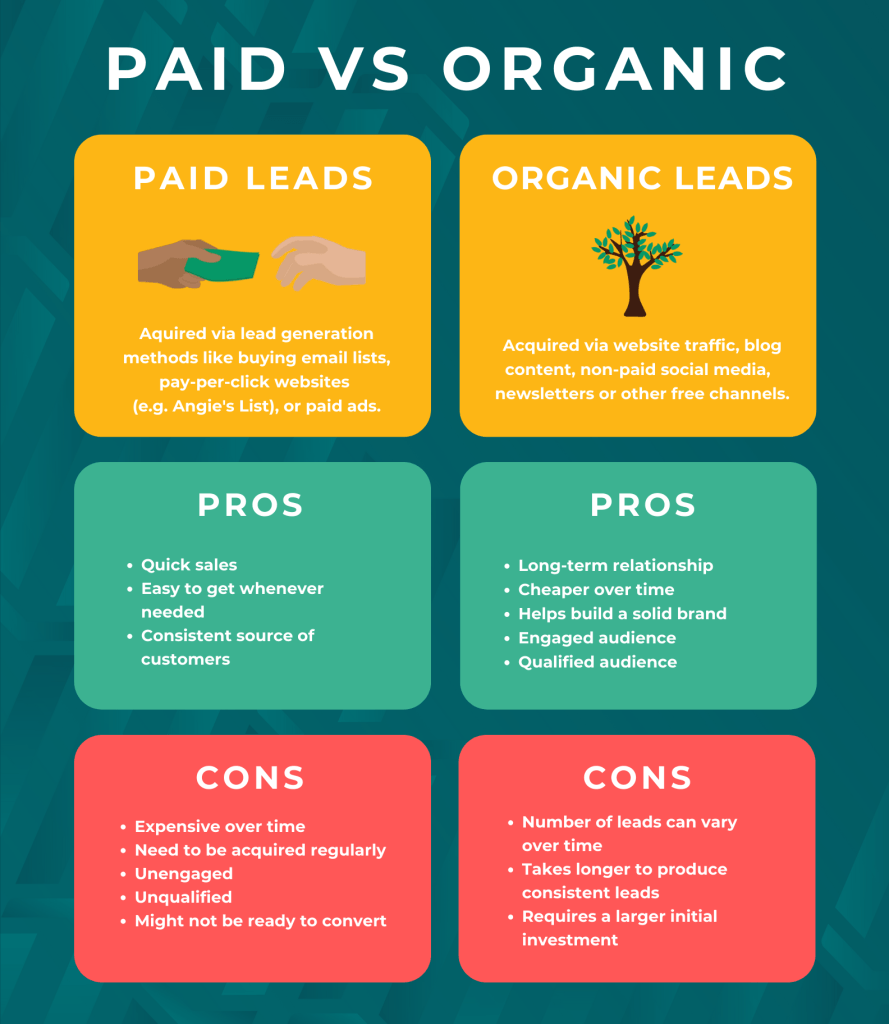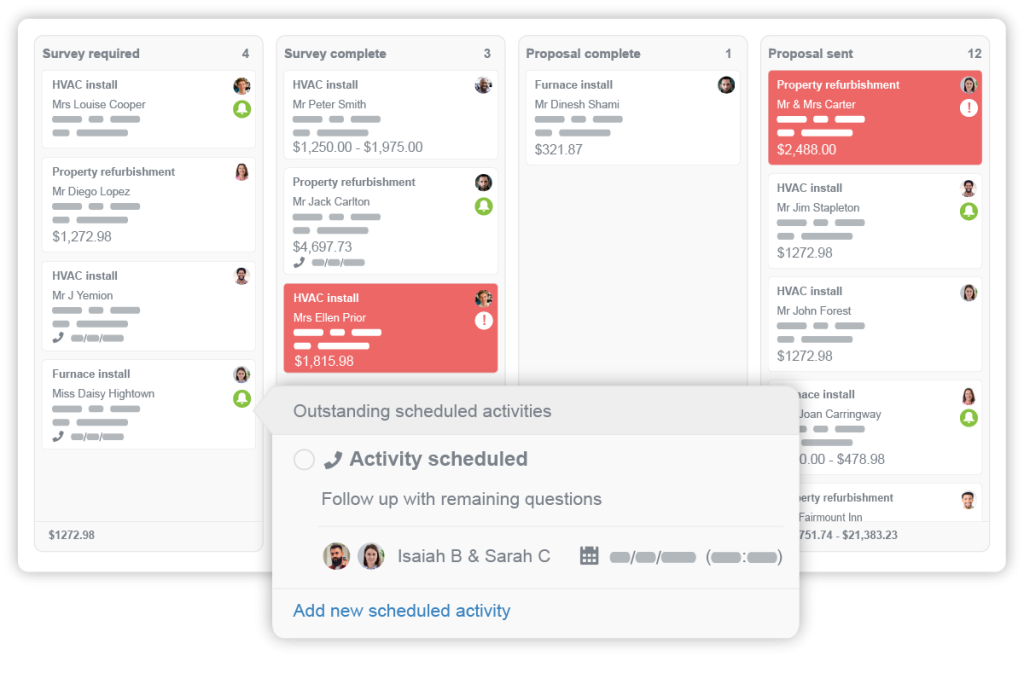Breaking down the Buyer’s Journey – how does it affect the HVAC sales process?
The HVAC sales process can be intricate—that’s no surprise. But businesses determined to stay ahead know the key to success lies in continuous improvement.
Whether it’s hiring the best talent at the right time, automating repetitive administrative tasks, or investing in employee training, industry leaders understand that growth demands progress. They’re always searching for smarter ways to refine their operations.
One proven strategy for innovation is breaking down a complex process and examining it step by step. When it comes to the HVAC sales process, the best approach is to see things from the perspective of your customer. Walk through the buyer’s journey, and you’ll uncover invaluable insights.
Ready to take the first step? Let’s go!

1. The buyer’s journey for the HVAC sales process
The difference between the HVAC sales process and the HVAC buyer’s journey is that the first is from your perspective, while the second is from the customer’s perspective.
The HVAC Sales Process can be split into 6 stages:
- Inquiry
- Survey
- Proposal
- Follow-up
- Winning Proposal
- Customer Experience
It may not be necessary to go through all these stages every time.
You might be the type of HVAC company that doesn’t do surveys or prefers flat rate pricing instead of proposals – so feel free to tailor the steps to your situation.

Keep in mind that the final stage (Customer Experience) represents the moment you officially start doing the work. Everything else leading up to it is part of the sale.
If you want to learn more, check out our Customer Experience guide!
On the other hand, the buyer’s journey from the customer’s perspective is usually described as: Awareness, Consideration, and Decision. First they become aware of their problem, then they consider potential solutions, and finally make a decision.
However, you might find it easier to break the HVAC buyer’s journey into four business-oriented stages:
- Attract (customers that are in the Awareness stage)
- Convert (by becoming the main contender in the Consideration stage)
- Close (the customer’s Decision)
- Delight (the customer’s expectations and turn them into an advocate for your brand)

If you take both diagrams into consideration, you’ll see that the steps in the HVAC sales process correspond roughly to the stages in the buyer’s journey like this:
- Attract via Inquiry and Survey
- Convert via Proposal
- Close via Follow-up and Winning the Proposal
- Delight via Customer Experience
Sit down and assess your own process according to these stages. This should shed more light on where you need to focus in order to improve and work towards growing your business. The next section will walk you through two main methods of attracting customers, so keep on reading!
2. Considering paid vs. organic leads for your HVAC sales process
Leads (or prospects) are potential customers who come across your business, usually, in one of two ways: through paid advertising (buying email leads, Pay-Per-Click, or paid social/Google ads) or via organic search (website traffic, blog content, organic social media, etc.).

If you’re trying to grow quickly and are looking for a consistent source that delivers exactly the number of people you need, then paid leads are a better option than organic leads.
This being said, organic leads are more useful if you’re in it for the long term. It might take some initial investment in great content (check out why you should have a blog) but it will help you build a solid brand and establish a true relationship with your customers. Since you don’t have to invest regularly, as you do with paid leads, this option can end up cheaper in the long run.
3. Optimizing the HVAC buying journey through content
The buying journey will inevitably take people to your website, especially in the Attract stage. You want to make sure you’ve got all the information they need, as well as demonstrate you’re the kind of business they can trust.

Your website and content will go a long way towards getting customers to choose you out of a myriad of competitors. Everything from how neat your homepage is to how easy it is to navigate, whether it has a booking portal, and if there’s a helpful blog to resolve simple issues – it will work in your favor to help you generate and close sales
Pathmonk, the website experience experts, interviewed Commusoft’s Content Manager, Cristina Maria, on their podcast and asked some big questions about improving the buyer’s journey with the right content. She recommended two things, in particular:
- Identifying your target audience.
- Creating HVAC sales content for your target audience, not for yourself.
Identifying your target audience
One of the most impactful lessons I’ve learned about optimizing the HVAC sales process is the importance of stepping into the customer’s shoes. It’s a simple concept, but one that’s easy to overlook.
At first, I thought I was already doing this—but in truth, my perspective was still influenced by my own biases. I was focusing on my goals, not the customer’s needs. Once I reevaluated, the difference was clear, and it completely changed the way I approached my audience.
Consider your business model. Do you primarily handle residential installs for homeowners? Or is the majority of your work routine maintenance? Perhaps commercial contracts make up the bulk of your revenue. Knowing the answer to these questions will help you identify your broad audience, but it’s not enough to stop there.
When you truly understand your audience, you can anticipate their needs at every touchpoint in the HVAC sales process. Address those needs with crystal-clear communication and personalized solutions.
Whether it’s providing a seamless booking experience, offering tailored recommendations during a consultation, or sending follow-ups that add value long after the job is done, this level of attention builds trust.
By making the effort to see things through your customer’s eyes, you’ll not only elevate their experience but also position your business for long-term success.
If you’re struggling with making a decision about your website content, answering these audience questions will help you. For example: do you target younger customers?
Today’s consumers value convenience, technology, and social responsibility. Presenting yourself as a service that lets customers do everything online (particularly for attracting Millennials), showing you care about relevant social issues, and talking about easy fixes on your blog will go a long way to winning them over. “Millennials and Gen-Z also find calls rude and anxiety-inducing. “81% of respondents admit that they often experience anxiety when talking to someone on the phone.” (GoDeskless, 2025)
Creating HVAC sales content for your target audience, not for yourself
At the end of the day, selling to yourself is not that difficult. But your customers might, probably, won’t be you. My audience isn’t. They consume content in a different way that I do. So I need to adjust to that.
A simple way of creating content for your audience (and not for yourself) is making sure you’re always focused on the why, not the what.
For example, you may have scheduling software to help you better organize your diaries, but you’ll still offer emergency same-day repairs. Why? Because you know emergencies are unpredictable. Customers won’t want to rely on your job scheduling software alone. They just want to be confident that you can always react to deliver the service they need, when they need it. It’s about fulfilling your customers’ needs, not only what’s most convenient for you.
Another concrete example: our newsletter. The first time we thought about designing the newsletter, we took inspiration from our favorite sources of content. In that sense, I’m perhaps a little bit more traditional and like reading a lot of newspaper editorials, a lot of very basic wall of text sort of structures, which obviously didn’t work because we do not have the same target audience.
So we had to go through a couple of iterations in order to judge the user journey. More images, videos, our own podcast. Put all of that in the beginning. Less text. These are not very glamorous tweaks. But they can definitely make a massive difference to the person you’re selling to.
Cristina Maria, Commusoft
4. Writing an HVAC sales pitch in your proposal
A proposal should make the customer feel like they’re aware of the situation and in control of the outcome. This is why your HVAC sales pitch should focus on how and why you’re able to offer that, instead of simply sending people a price breakdown.
Simply offering additional details and options will create a much more positive and straightforward customer experience. You’ll quickly stand out from the competition and companies that aren’t willing to go that extra mile.
Additionally, your sales pitch should demonstrate that:
- You’re committed to delivering a high quality service and product from start to finish
- You respect the customer’s intelligence and autonomy to choose the best option based on your recommendations
- While there might be competitors out there who will do it for less money you can offer a superior service at a reasonable, worthwhile price
- It’s important for them to take action as soon as possible in order to secure the offer you’ve made
5. Communicating with leads at the right time
When a customer sends an inquiry and doesn’t receive a response within a couple of hours, they’ve most likely concluded either your business doesn’t exist or you don’t care, neither of which will help you! This is a failed buyer’s journey.
Acknowledgement is key to success! Even if it’s just a template confirmation saying “We’ve received your request” is enough to give customers some peace of mind.
Keeping in touch with the customer throughout the sales process will create a relationship and increase the likelihood of you closing the deal. Ideally, you’d contact a lead to:
- Book a survey in the first 48 hours.
- Send them a proposal soon after the survey is done
- Send a follow-up if they don’t sign (which could include a time-based offer like “10% discount if you accept before the end of the week!”)
- Post a confirmation that their proposal acceptance has been recorded and someone will reach out to book the job
- Send a feedback request email to ask how they found the sales process

That’s a lot of emails, you might be thinking. And you’d be right! But you can use your HVAC software to schedule these to go out automatically or use your Google calendar to remind you to send them out manually.
At the end of the day, timely communication can easily set apart a winning business from a losing one, so it’s well worth the investment.
What to takeaway on improving your HVAC sales process
Improving your HVAC sales process is a continuous learning curve. Trial and error will play a significant role. Over time, you’ll refine and perfect your approach. Still, it’s important to recognize one key challenge many businesses face.
Is it fair to expect engineers and office managers to excel at their primary responsibilities and also become seasoned sales and communication experts? Probably not, and that’s okay.
The truth is, you don’t need to be a professional negotiator to keep potential customers engaged in the pipeline. What matters most is having effective communication strategies in place, especially when it comes to discussing pricing.
A well-crafted message delivered at the right moment can be the deciding factor between winning a loyal customer for life or losing them to a competitor. Analyzing and optimizing your HVAC sales process starts with understanding one fundamental principle: communication is at the heart of every successful sale.
Equip your team with the right tools, training, and support. This will ensure that every interaction leads with clarity and resonates with the customer’s needs. By doing so, you’ll not only build trust but also set your business apart in a competitive market.

Cristina Maria
I'm here to bring you next-level strategies to the field service industry. When I'm not working on the best tips to grow your business, I'm on the lookout for sci-fi novels and cookie recipes.









